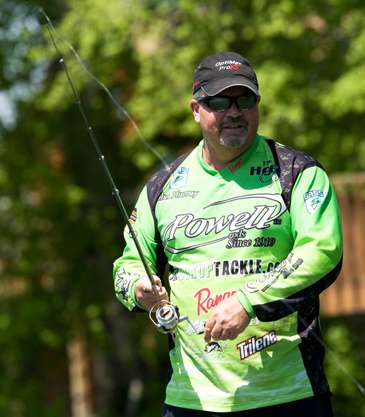
The West — while not so wild anymore — is distinctly different than the East. Folks on both coasts acknowledge this. The same holds true in East versus West bassin'. The West's Japanese influence means they see the innovative baits and techniques of the Far East first. The canyon-like lakes couldn't be more different from the shallow, muddy bowls found in parts of the East.
In each segment of this three-part series we'll detail a technique that is being used on the Left Coast, starting with John Murray and the Hideki rig.
Murray is a legend in these parts. He has won 31 fully rigged bass boats on every major waterway from the super deep canyon-lined reservoirs of New Mexico to the big bass havens of California up to Washington state. He's been fishing professionally since 1985 and has been on the leading edge of Western bass fishing trends.
In this first installment, Murray will detail the Hideki rig. The rig is also known as the 'Dek rig and is named for inventor and Western pro Hideki Maeda.
"Basically the 'Dek rig is a form of wacky rigging," Murray explains. "It's a wacky rigged Senko with a tungsten nail in it. I know that doesn't sound much different from regular wacky rigging, but the difference lies in the presentation.
The rig is comprised of a stickbait, a tungsten nail and an Owner Mosquito hook. Don't get tied to a Senko, though. Murray will also use finesse worms and the occasional craw. Tungsten nails are better than lead for their denser properties; you get more weight with less. Depending on how deep you're going to work it, you'll want anywhere from a 1/16- to 1/4-ounce nail. Murray likes the Mosquito hook because it is self-setting. If he's fishing around submerged trees, he'll select a similar Owner hook with a weedguard
The rod is critical to imparting the correct action to the worm. Murray likes a 7-foot, 3-inch medium-heavy Powell 733 spinning rod with 6-pound-test Seaguar fluorocarbon
"When you're giving it the right action, it will be causing a lot of commotion without going very far," he says. "You just want it to hop up and down to make it look like it's trying to bury itself in the ground."
The theory behind the 'Dek rig is that when a Senko is weighted in one end only, it falls vertically and — when weighted properly — will stand up once on the bottom.
"This isn't a wacky rig that you throw by a tree and let sink," Murray says. "Instead of moving sideways, it goes up and down and hops and shakes while you're working it. When it moves across the bottom it has a different look than even a shaky head."
Murray likes to fish the rig in deep — 20 to 50 feet — water and in the extremes of winter and summer. He favors the colder months, though. He works it along the many deep ridges and points that Western reservoirs are known for.
Murray emphasizes four key points for those new to the 'Dek rig.
"First, it's not like dragging a worm around; it's using the rod tip to shake it. You can shake it fairly violently, but make sure you're shaking it more than you're dragging it, all the way back to the boat.
"Next, they'll just swim off with it. There's no tap. Remember not to set the hook. Just tighten up and lean into 'em.
"Third, there really is no way to fish it wrong. Get it out there and make sure you have a weight that matches the depth at which you're fishing. Sometimes you don't have to do a lot to it, other times you've got to really shake it.
"Finally, make a long cast. Lob it out there, let it settle down and start shaking the rod tip," he says. "It's amazing how many will pick it up either when it's falling or when you're shaking the rod tip."




